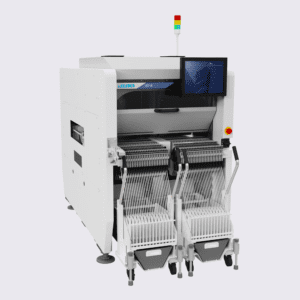The Tricks of Putting Together PCBs: A Brief Look:
When it comes to making electronics, Printed Circuit Board (PCB) building is like a very careful art form. To turn a plan into a real, working circuit board, you need an accurate drawing, a lot of skill, and the right tools. In this first part, the main idea of PCB assembly is explained, along with its importance and the background information needed for the next, more in-depth section.
Putting electronic parts on a PCB, which gives the plan life, is the most important part of the assembly phase. There are many different methods, each with its own specifics. These include solder paste stencil, surface mount technology (SMT), and through-hole component insertion.
The Art of Solder Paste Stencilling:
Next, we’ll look at the art of solder paste stencilling, which is an important step that comes before placing the components. As part of this process, solder paste is put on certain parts of the PCB where the components will go. Depending on how well this is done, it can have a big effect on how reliable and well the built PCB works.
In stencilling, a screen or stencil is needed to make sure that the paste goes exactly where it needs to. Solder paste is a fusible metal mixed with a flux medium. The amount of paste, the angle of the squeegee, and the amount of pressure used must all be carefully coordinated in order to get the right deposition.
Using SMT and through-hole techniques to precisely place parts:
During our learning of PCB assembly, we come across two main ways to place components: Surface Mount Technology (SMT) and Through-Hole. Each requires a different set of tools and techniques, and any PCB assembly expert needs to know about both.
SMT is a more modern method that involves putting parts right on the PCB’s surface. This makes better use of space and lets more machines do the work. Through-Hole, on the other hand, needs parts to be put into PCB holes that have already been drilled. This makes the physical bonds stronger, which is good for parts that are under a lot of mechanical stress.
Making sure of excellence: checking and controlling quality in PCB assembly:
Making sure that each circuit board is the highest quality is the last step in the PCB assembly process. At this stage, the PCB is carefully inspected and quality control steps are taken to find any flaws that could affect its functionality.
Some of the methods used to carefully check the PCBs are Automated Optical Inspection (AOI) and Functional Circuit Testing (FCT). AOI uses high-resolution cameras to look at solder joints and where components are placed, and FCT checks the electrical performance to make sure the PCB works.
Frequently Asked Questions about Putting Together PCBs:
1. What do you need to put together a PCB?
To put together a PCB, you’ll need solder paste, PCBs, electronic parts, stencils for applying the paste, and different tools for placing and soldering the parts.
2. What is the difference between SMT and Through-Hole?
Which one you choose relies on what your circuit needs. Through-Hole is better for parts that need strong mechanical links, while SMT is better for high-density, small form factor boards.
3. What does solder paste do when putting together a PCB?
To make the solder links that connect the parts to the PCB, you need solder paste. It needs to be used carefully to make sure that the connections are strong and effective.
4. How can I be sure that the PCB I put together is of good quality?
Use thorough checking methods like AOI and FCT, and follow strict quality control rules while putting the parts together.
5. What are some problems that often happen when putting together a PCB?
Problems that happen a lot include misplaced parts, too much or too little solder, and solder bridging. Careful process control and inspection can help lessen these problems.
6. Can PCB construction be done by a machine?
Yes, pick-and-place robots, reflow soldering ovens, and inspection systems can be used to automate a lot of PCB assembly, especially when SMT is used.
7. What are the pros of using machines to put together PCBs?
Automation improves accuracy, speed, and regularity in putting together PCBs, which cuts down on mistakes and production time.
8. How is the placement of parts done in SMT?
Pick-and-place machines that correctly place the parts on the solder paste-covered PCB before soldering are used in SMT.
9. Can I put together a PCB at home?
Yes, hobbyists can put together PCBs at home if they have the right tools and know-how. The boards will not be as complicated as those used in factories, though.
10. Where does PCB construction go from here?
More automation, better materials and techniques, and the ability to work with Industry 4.0 technologies are expected to be part of the future of PCB assembly.



